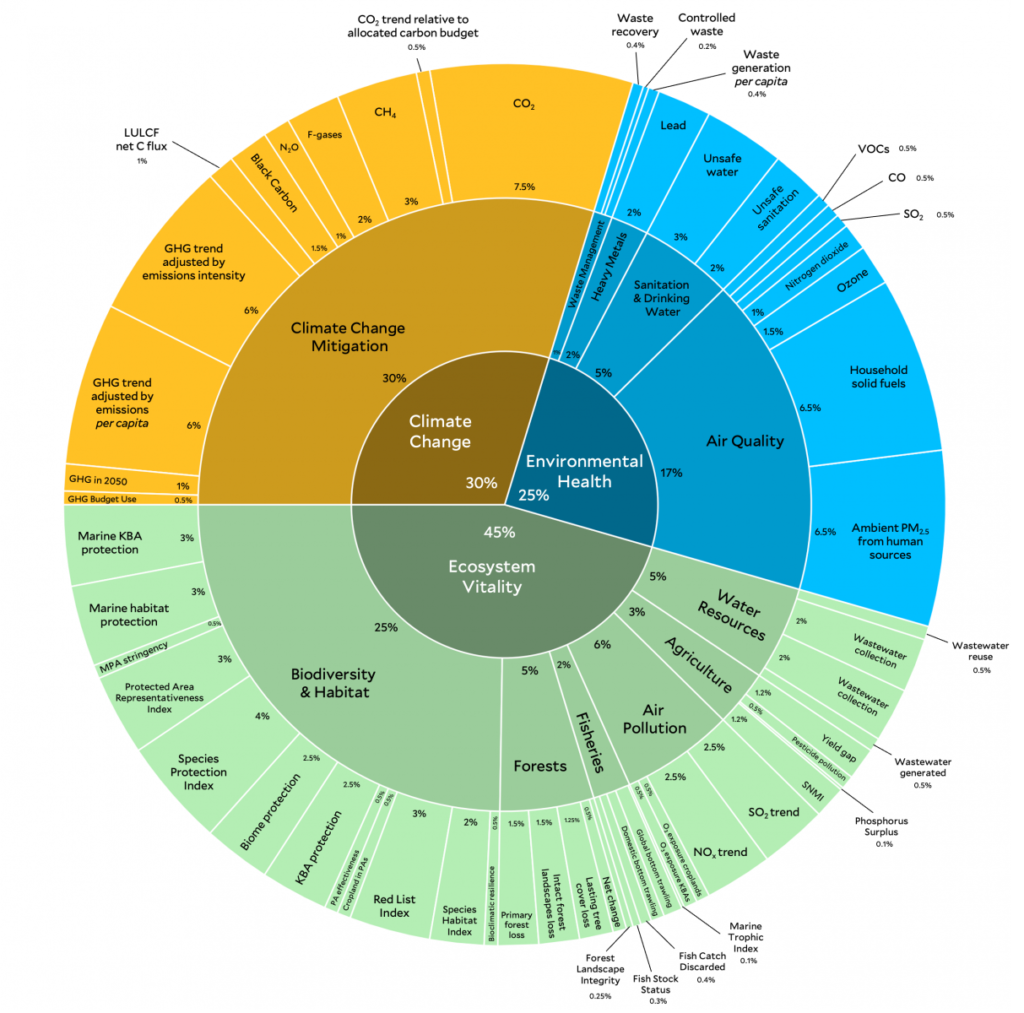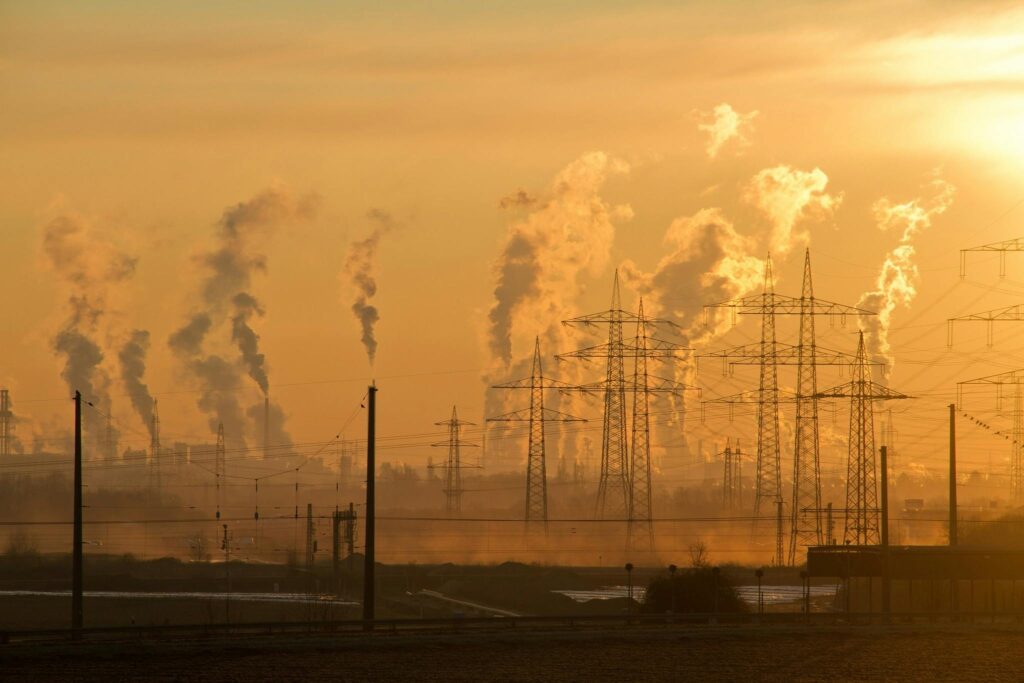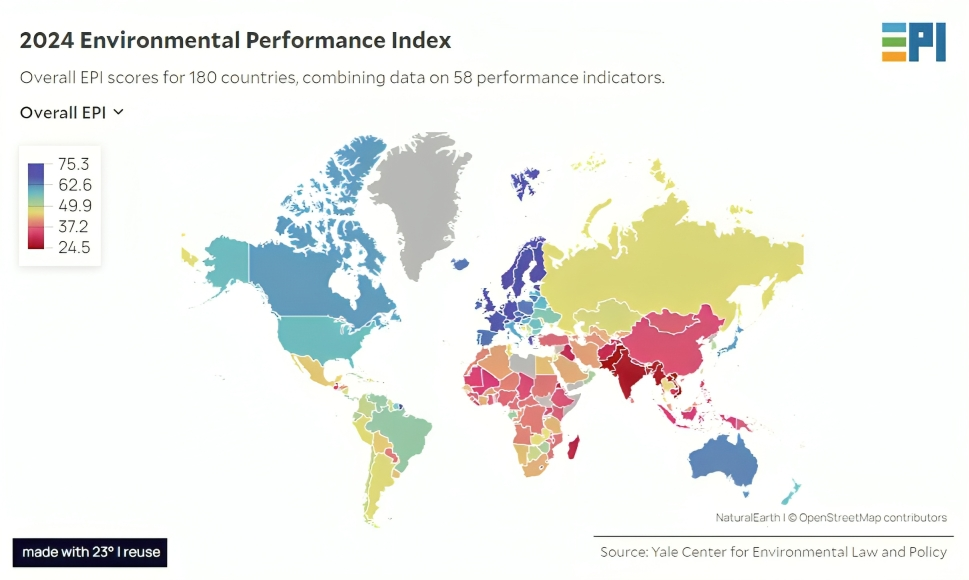India’s environmental performance has come under significant scrutiny, as reflected in the 2024 Environmental Performance Index (EPI). Ranking 176th out of 180 countries with a score of 27.6 points, India faces severe challenges in air quality, emissions, and biodiversity conservation. Despite some progress in climate change mitigation, the country’s reliance on coal and rapid urbanization contribute heavily to its low ranking. This article explores the factors behind India’s environmental performance, the initiatives underway, and the criticisms of the EPI’s methodologies. The image below shows the EPI framework which organizes 58 indicators into 11 issue categories and three policy objectives, with weights shown at each level as a percentage of the total score. Image Source- https://epi.yale.edu/

Table of Contents
What is the Environmental Performance Index (EPI)?
The Environmental Performance Index (EPI) is a biennial ranking developed by the Yale Center for Environmental Law and Policy and the Columbia Center for International Earth Science Information Network. It evaluates countries on their environmental health and ecosystem vitality using a variety of indicators. The EPI aims to highlight global and regional disparities in environmental performance, providing a data-driven summary that can guide policy and promote sustainable practices worldwide.
EPI 2024
The Yale Center for Environmental Law and Policy and the Columbia Center for International Earth Science Information Network have released the Environmental Performance Index (EPI) for 2024, highlighting significant global and regional disparities in environmental performance. Estonia leads the index, having reduced its greenhouse gas emissions by 59% from 1990 levels, setting a benchmark for sustainable practices. However, the report shows that only Estonia, Finland, Greece, Timor-Leste, and the United Kingdom are cutting their emissions at a rate necessary to reach Net-zero by 2050. In contrast, Sub-Saharan Africa and Southern Asia rank lowest among the eight regions assessed, reflecting substantial challenges in environmental management.
Introduction of New Metrics in 2024 EPI
The 2024 EPI has introduced new pilot indicators to evaluate the effectiveness and stringency of protected areas. These metrics aim to provide a more comprehensive understanding of conservation efforts and their impact on biodiversity. The implementation and utility of these new indicators will need to be closely monitored to ensure they accurately reflect the state of environmental conservation.
Past EPI Rankings of India
India’s ranking in the Environmental Performance Index has seen a troubling decline over the years. Between 2000 and 2012, the country maintained a ranking between 122 and 127. However, from 2014 onwards, there has been a marked deterioration in environmental performance. By 2018, India’s ranking had plummeted to 177, reflecting significant environmental challenges. Although there was a slight improvement to 168 in 2020, the ranking fell again to 180 in 2022, the lowest possible position. This trend underscores the urgent need for enhanced environmental policies and sustainable practices.
Key Factors Contributing to Poor Performance
Air Quality and Emissions

India’s air quality is one of the worst globally, ranking 177th in this category. The heavy reliance on coal as a primary energy source is a major contributor to poor air quality. Coal combustion releases high levels of greenhouse gases (GHGs) and particulate matter, severely affecting public health and the environment. Urban areas, especially cities like Delhi, are engulfed in dense smog, leading to respiratory issues and other health problems for millions.
Biodiversity Conservation
India’s rapid industrialization, deforestation, and urban expansion have led to significant habitat destruction and biodiversity loss. The country ranks poorly in biodiversity conservation due to inadequate funding, weak enforcement of conservation laws, and complex ecosystem management challenges. Conservation efforts are often hindered by the lack of comprehensive data and resources needed to protect diverse species and habitats.
Transboundary Pollution
India’s environmental issues extend beyond its borders, significantly impacting neighboring countries. As the largest emitter of transboundary pollution in South Asia, India’s emissions adversely affect air quality in Bangladesh and other neighboring regions. This cross-border pollution exacerbates health issues and environmental degradation, highlighting the need for regional cooperation to address these challenges.
Climate Change Initiatives
Despite its poor overall performance, India shows relative progress in the climate change category, ranking 133rd. This can be attributed to substantial investments in renewable energy, particularly solar and wind power. India has set an ambitious target of achieving net-zero emissions by 2070. However, realizing this goal requires an additional USD 160 billion annually in climate change mitigation investments. The financial challenge is significant, but the commitment to renewable energy offers a glimmer of hope for reducing the country’s carbon footprint. More can be read here.

Areas of Relative Strength
India demonstrates relatively stronger performance in areas such as solid waste management, forests, and agriculture. These sectors have seen improvements due to targeted policies and investments. However, the gains in these areas are overshadowed by the severe deficiencies in air quality, emissions, and biodiversity, which drag down the overall EPI ranking.
Issues Raised by India Regarding EPI Methodologies
Projected GHG Emissions Calculation
India has raised concerns about the EPI’s method of projecting GHG emissions based on the average rate of change. This approach is seen as inadequate, as it does not account for the full spectrum of mitigation measures and technological advancements that could alter future emission trajectories.
Biodiversity Measurement Challenges
Measuring biodiversity loss and ecosystem health is complex due to the intricate dynamics involved and the absence of standardized methodologies. This complexity is particularly challenging in a biodiverse country like India, where accurate data collection and analysis are essential for effective conservation.
Exclusion of Carbon Sinks
India argues that its forests and wetlands, which serve as significant carbon sinks, are not adequately factored into the EPI’s GHG emissions projections. These natural carbon sinks play a crucial role in offsetting emissions and should be included in the assessment to provide a more accurate picture of the country’s environmental performance.
Ecosystem Condition
The EPI focuses on the extent of ecosystems but does not evaluate their condition or productivity. Assessing the health and functionality of ecosystems is essential for a comprehensive evaluation of environmental performance. India emphasizes the need to consider ecosystem conditions in the EPI methodology.
Lack of Relevant Indicators
The EPI does not include indicators like agro-biodiversity, soil health, food loss, and waste, which are crucial for a country with a large agrarian population. India advocates for the inclusion of these indicators to ensure sustainable development and better reflect the country’s unique environmental challenges.
Conclusion
India’s environmental performance, as reflected in the 2024 EPI rankings, underscores the need for urgent and comprehensive action to address critical issues such as air quality, emissions, and biodiversity conservation. While there are areas of relative strength and ongoing initiatives in renewable energy, the overall picture is one of significant concern. By addressing the shortcomings in current methodologies and investing in sustainable practices and local solutions, India can work towards improving its environmental performance and ensuring a healthier future for its population and the planet
FAQs
What is the Environmental Performance Index (EPI)?
The Environmental Performance Index (EPI) is a biennial ranking that evaluates countries’ environmental health and ecosystem vitality based on various indicators. It aims to provide a data-driven summary of the state of sustainability worldwide.
Why is air quality so poor in India?
Air quality in India is poor primarily due to the heavy reliance on coal for energy, industrial emissions, vehicular pollution, and the widespread use of biomass for cooking in rural areas. These factors contribute to high levels of particulate matter and smog in urban areas.
How is India addressing climate change?
India is addressing climate change by investing in renewable energy sources like solar and wind power. The country has set a target of achieving net-zero emissions by 2070 and is working towards reducing its carbon footprint through various initiatives and policies.
What are the criticisms of the EPI methodology?
Criticisms of the EPI methodology include the exclusion of carbon sinks such as forests and wetlands, inadequate consideration of technological advancements in projecting GHG emissions, and the lack of relevant indicators for agro-biodiversity and soil health. These omissions can lead to an incomplete assessment of a country’s environmental performance. For more information Click
How can India improve its EPI ranking?
India can improve its EPI ranking by enhancing air quality through stricter pollution controls, investing more in biodiversity conservation, addressing transboundary pollution issues, and increasing funding for environmental initiatives. Additionally, advocating for the inclusion of relevant indicators in the EPI can provide a more accurate reflection of the country’s efforts and challenges.





